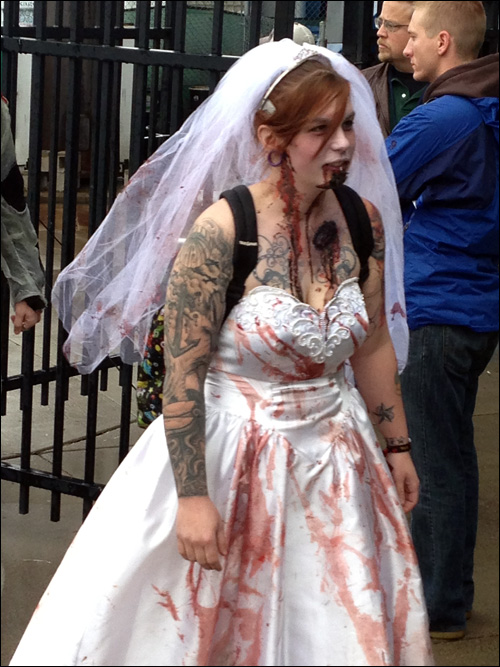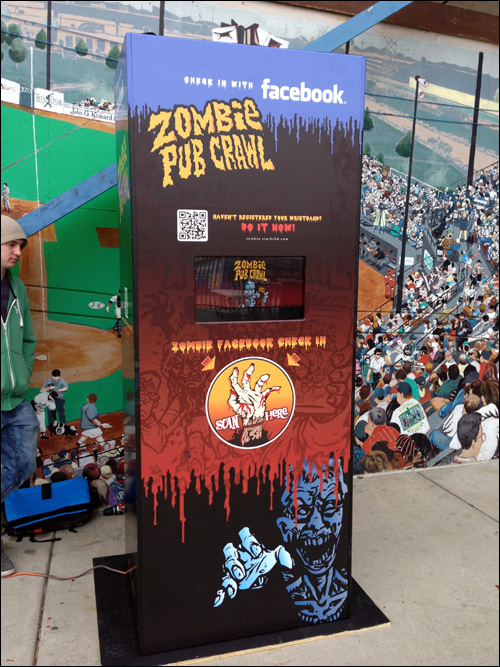No zombie likes to wait in line, which is why more than 30,000 Twin Cities members of the undead wore radio frequency identification tags on a Saturday night earlier this month. Etix, the ticketing service provider of Zombie Pub Crawl VIII, held in Minneapolis and St. Paul, Minn., employed an RFID-based solution to provide access control to a music venue known as Zombie Island, as well as to track crowd movements through pubs and bars, and help participating “zombies” post details regarding their evening on Facebook. After the event, the number of attendees counted by the system was forwarded to Guinness World Records, which will determine whether a new world record was reached regarding the number of zombies gathered within a single place. The previous record was 4,093, set on Oct. 30, 2010, in Asbury Park, N.J. Until Guinness releases its decision, the solution’s provider, Stark RFID, says it cannot reveal the exact number of attendees counted.
To participate in the event, each zombie purchased a ticket for about $20, and was issued a wristband containing an Alien Technology EPC Gen 2 passive RFID inlay. The wristband tags were read as the zombies staggered through RFID reader portals while entering the main venue (St. Paul’s Midway Stadium). Employees of bars and pubs throughout Minneapolis and St. Paul were equipped with handheld RFID readers, which they used to capture the unique ID number of each zombie’s wristband tag as he or she entered the premises or ordered drinks.

This year’s event marked the eighth annual Zombie Pub Crawl in the Twin Cities. The number of visitors has grown every year since the first Zombie Pub Crawel, in 2005, which attracted approximately 100 participants. This year’s event included more than 25 musical bands, along with at least a dozen participating pubs in both Minneapolis and St. Paul.
This was the first time that the event included RFID tags, however. Without them, entrance into Midway Stadium would have required that individuals queue up and present a paper ticket before entering. If paper tickets had been used, staff members would have been required to manually check the tickets, even via bar-code scanners, to verify their validity. That manual process would have interfered with the free flow necessary to create an atmosphere of swarming (and partying) zombies. In addition, the sheer volume of attendees would have made it impossible to thwart some gatecrashers who might take advantage of the crowded confusion and sneak in without paying.
This year, the undead had to purchase their tickets at the Zombie Pub Crawl’s Web site, and then acquire an RFID wristband at a local store, either in advance or at a redemption tent on the night of the Crawl. Once that task was accomplished, however, they could then move freely at the event without presenting tickets. Meanwhile, event organizers could maintain an eye on where crowds gathered, as well as where bottlenecks might occur. The system also made it possible to count the number of zombies entering the stadium, in order to determine whether the existing Guinness World Record had been broken. According to Lance Burnett, Stark RFID’s president, those numbers are still being reviewed by Guinness, but it is likely that the world record was, in fact, broken, based on the number of tickets sold prior to the event. (The majority of tickets were purchased that same night.)
With the system in place, zombies could first order their RFID-enabled wristband online from Etix, via the Zombie Pub Crawl Web site. They could then print a paper ticket and present it at a participating store, or at a redemption tent, to claim a wristband, says Michael Reklis, Etix’s account manager. Workers at these locations scanned each ticket’s bar code to confirm its authenticity, and then provided the RFID wristband.
Burnett says he opted for ultrahigh-frequency (UHF) technology, rather than high-frequency (HF), to provide a longer read range in order to move attendees more quickly through portals (since each zombie would not be required to stop and present a wristband to be read at close range). “Zombies don’t run,” he says, “but they also don’t like to stand in line.”
Each individual attached the cloth wristband around his or her wrist. Upon arriving at the stadium, zombies walked through one of 28 reader portals allowing them entrance to the concert. Each Alien ALR-9900+ fixed reader was wired to four antennas, enabling Stark to run four portals off a single reader. This helped make the installation and removal of the technology faster and easier, Burnett explains. The interrogators were then wired to a PC running Stark RFID software. As the readers interrogated the unique ID number encoded to each wristband, that ID number was compared to the IDs on file in the Stark RFID software, and if there was a match, that zombie was approved for entrance, with the read event stored. Simultaneously, a light was illuminated, confirming each valid read. In the event that the system failed to read a tag, the illumination did not occur, thereby indicating to the staff that there was a problem. In some cases, supplemental handhelds were used to hasten the hordes’ passage through the entrances.
While leaving the venue, the zombies passed through turnstiles to help event planners count the number of undead leaving.
An additional four kiosks enabled zombies to utilize their RFID wristbands to post messages on Facebook. Prior to the event, ticket holders were encouraged to access the Zombie Pub Crawl Web site and register for social-media linkage to their wristbands. Each participant could simply input his or her Facebook or Twitter account number, and link that account with the wristband’s unique ID. Upon arriving at the kiosks, the zombie first presented the wristband to the built-in reader, and then selected a message to post, such as “brains brains brains brains beers brains” or “grangh muum gnaaaahhhhhh.” That ID number was then forwarded to the Stark RFID software, where that person’s tag ID had been linked to his or her Facebook or Twitter user ID. Those who failed to register for social media ahead of the event could still access the social-media sites, by using a QR code on the kiosk to connect with the site and thus provide a user ID to that individual’s account.
For those visiting the pubs, the RFID technology provided access and drink discounts as well. Approximately 20 pubs and bars received Alien ALH-9000 handheld readers to read the wristband of each entering individual. Only those wearing wristbands were admitted. This data was then stored in the handheld’s firmware, to be later uploaded by Stark RFID. The RFID company will now provide analytics regarding crowd movements at each location to the event planners.
The greatest challenge for Stark RFID, Burnett says, was the need for very fast deployment and removal of the technology. The company’s staff had a 12-hour period of time in which to install the portals and distribute handheld readers. He says the readers were configured to interrogate tags passing through the portal at a “normal stride.” Working with rotting flesh was no major challenge, he notes, since “the reduction in water content” in dead flesh makes the RFID reads that much easier.


